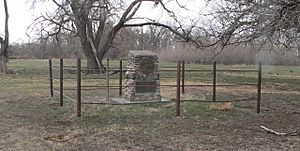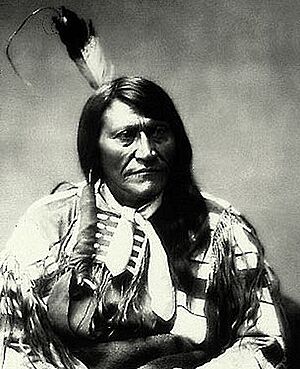Battle of Mud Springs facts for kids
Quick facts for kids Battle of Mud Springs |
|||||||
|---|---|---|---|---|---|---|---|
| Part of the Colorado War | |||||||
 Monument at Mud Springs Pony Express station site |
|||||||
|
|||||||
| Belligerents | |||||||
| United States of America | Cheyenne, Lakota Sioux, and Arapaho tribes | ||||||
| Commanders and leaders | |||||||
| William O. Collins | |||||||
| Strength | |||||||
| 230 soldiers | 500-1,000 warriors | ||||||
| Casualties and losses | |||||||
| 1 dead, 8 wounded | few | ||||||
The Battle of Mud Springs happened in Nebraska from February 4 to 6, 1865. It was a fight between the U.S. Army and warriors from the Lakota Sioux, Cheyenne, and Arapaho tribes. The battle did not have a clear winner. However, the Native American warriors managed to capture some Army horses and a large group of cattle.
Today, Mud Springs is a National Historic Site. It is located about 8 miles northwest of Dalton, Nebraska.
Why the Battle Happened

In November 1864, a terrible event called the Sand Creek Massacre took place in Colorado. After this, the Plains Indians from the Lakota, Cheyenne, and Arapaho tribes decided to move north. They wanted to go to the Powder River Country in Wyoming, which was a more isolated area.
On their way, they sought revenge for the Sand Creek Massacre. For most of January, they raided along the South Platte River in Colorado. On February 2, they burned the settlement of Julesburg. The next day, they burned a telegraph station on Lodgepole Creek.
On February 4, a group of Sioux warriors arrived at Mud Springs. This was a stagecoach station that also had a telegraph. Only 14 men were at the station, including nine soldiers. They were protected by walls made of sod and logs.
Both the Native American warriors and the soldiers had good weapons. Bullets from 21 different types of guns have been found at the battle site. The Spencer carbine was a common gun for both sides. The warriors also used bows and arrows. They had plenty of food and supplies. They had gathered these during their raids in the South Platte Valley. This allowed them to stay together in a large group for a long time.
The Fight at Mud Springs
The first group of Native American warriors stole 18 horses and a large herd of cattle. The telegraph operator quickly sent messages for help. He contacted Fort Mitchell, which was 55 miles west, and Fort Laramie, 105 miles west.
The next morning, Lieutenant William Ellsworth and 36 men arrived at Mud Springs from Fort Mitchell. They had ridden all night to reinforce the station. Soon after, many Native American warriors arrived. There were more than 1,000 of them.
Ellsworth sent 16 men to a nearby bluff. He wanted them to stop the warriors from getting too close to the station. But about 500 warriors attacked these soldiers. The soldiers had to retreat back to the station. One soldier was killed and another was wounded.
In the afternoon, the soldiers inside the station opened the corrals. They let their horses run free. This worked as planned. The warriors surrounding the station spread out to try and catch the animals. By then, the warriors were also tired of shooting at the soldiers inside the thick-walled station. They went back to their camp, about 10 miles east.
At 2:00 AM on February 6, Colonel William O. Collins arrived at Mud Springs with 25 men. Early the next morning, the rest of his group arrived from Fort Laramie. This brought the total number of soldiers at the station to 170. His soldiers were very tired from a two-day march with little sleep. Many also had frostbite because of the bitter cold.
The main group of Native American warriors returned to Mud Springs that morning. Colonel Collins estimated there were 500 to 1,000 warriors. Collins protected his horses in a temporary corral made of four wagons. But about 200 warriors began shooting arrows at the horses and men in the corral from 75 yards away. They killed and wounded horses and injured some men.
Collins sent two groups of soldiers out. Their job was to push the warriors out of bow-and-arrow range. They also needed to capture and hold the higher ground. As the soldiers advanced, the warriors slowly pulled back. They then left the battlefield. That night, 50 more soldiers arrived with a 12-pounder mountain howitzer (a type of cannon). Collins planned to attack the next day, February 7. However, the Native American forces did not return to Mud Springs.
The soldiers had one man killed and eight wounded. Colonel Collins thought about 30 Native American warriors were hurt or killed. But the Cheyenne warrior George Bent said no Native Americans were killed.
What Happened Next
The large Native American camp was made up of possibly 4,000 to 5,000 people. This included men, women, and children. On February 6, they slowly moved to the North Platte River. They crossed the frozen river and camped among some bluffs. This was about 5 miles north of the river. The warriors returning from the battle joined them there.
The Native Americans planned to stay there for four days to rest their horses. They did not expect the smaller group of soldiers to follow them. However, Colonel Collins left some soldiers at Mud Springs. He then followed the Native American trail with 185 men. He found an abandoned camp. It was full of things the Native Americans had taken, like codfish, flour, and empty cans of oysters, meat, and fruit. He followed their trail to the North Platte River. There, he found the Native Americans and fought them again in the Battle of Rush Creek. One soldier later joked that catching the Native Americans "was an easy enough matter, but we had a terribly hard time letting them go."

